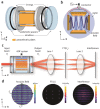Fast Acoustic Light Sculpting for On-Demand Maskless Lithography
- PMID: 31380209
- PMCID: PMC6662050
- DOI: 10.1002/advs.201900304
Fast Acoustic Light Sculpting for On-Demand Maskless Lithography
Abstract
Light interference is the primary enabler of a number of optical maskless techniques for the large-scale processing of materials at the nanoscale. However, methods controlling interference phenomena can be limited in speed, ease of implementation, or the selection of pattern designs. Here, an optofluidic system that employs acoustic standing waves in a liquid to produce complex interference patterns at sub-microsecond temporal resolution, faster than the pulse-to-pulse period of many commercial laser systems, is presented. By controlling the frequency of the acoustic waves and the motion of a translation stage, additive and subtractive direct-writing of tailored patterns over cm2 areas with sub-wavelength uniformity in periodicity and scalable spatial resolution, down to the nanometric range, are demonstrated. Such on-the-fly dynamic control of light enhances throughput and design flexibility of optical maskless lithography, helping to expand its application portfolio to areas as important as plasmonics, electronics, or metamaterials.
Keywords: acusto‐optics; direct‐write; laser‐interference; nanotechnology; optofluidics.
Conflict of interest statement
The authors declare no conflict of interest.
Figures




References
-
- Nie Z., Kumacheva E., Nat. Mater. 2008, 7, 277. - PubMed
-
- Andrew T. L., Tsai H.‐Y., Menon R., Science 2009, 324, 917. - PubMed
-
- Campbell M., Sharp D. N., Harrison M. T., Denning R. G., Turberfield A. J., Nature 2000, 404, 53. - PubMed
-
- Müller‐Meskamp L., Kim Y. H., Roch T., Hofmann S., Scholz R., Eckardt S., Leo K., Lasagni A. F., Adv. Mater. 2012, 24, 906. - PubMed
-
- Priolo F., Gregorkiewicz T., Galli M., Krauss T. F., Nat. Nanotechnol. 2014, 9, 19. - PubMed
LinkOut - more resources
Full Text Sources
